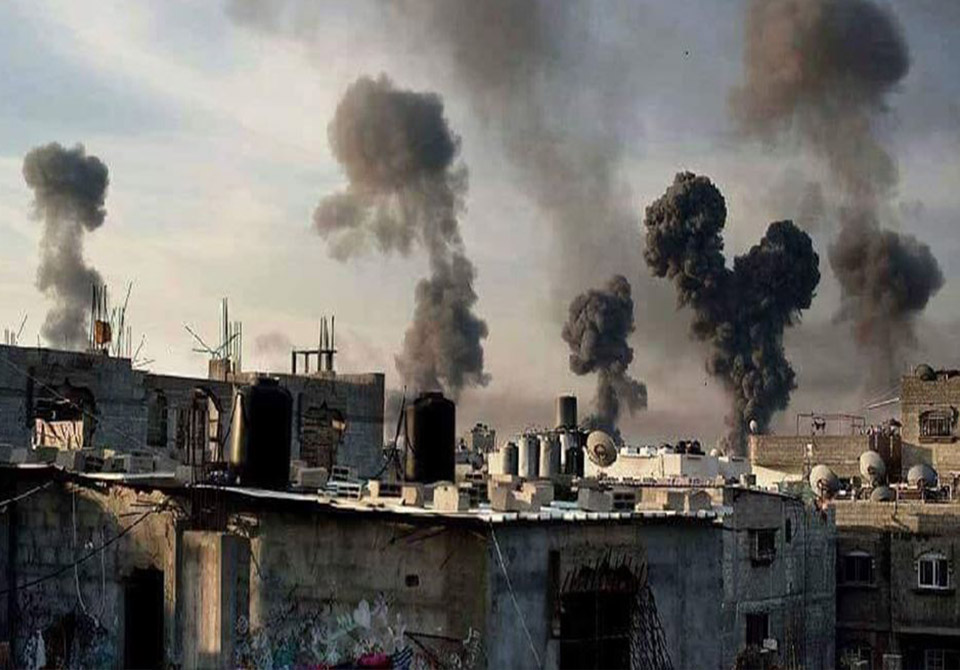10 years later. The memory of Israel’s first onslaught on Gaza lives on

Ten years ago, on Saturday morning, 27 December 2008, it was a calm day in the Gaza Strip, where people were doing their work under a gruesome Israeli siege that had been going on for almost two years
At 11:27 am, the Israeli occupation forces attacked the Gaza Strip when 80 Israeli warplanes poured their deadly missiles on dozens of civilian and security sites in the various areas of the Gaza Strip. During these strikes, more than 200 citizens were killed.
Cruel crimes
Bodies were everywhere, dozens of martyrs arrived at the same time to the hospitals. The bodies of martyrs and wounded were mixed up, so that some of the wounded were transferred to the morgues unintentionally, following the horrors and confusion resulting from the situation.
One cannot forget those scenes; it was a massacre by Israelis that was broadcasted to the world just as it happened, shocking everyone.
The Israeli thirst for committing crimes didn’t stop at the first crime of collective air strikes all over Gaza, but also it continued during eight days of intensive and unprecedented shelling in various areas of the Gaza Strip, while the Palestinian resistance responded by shelling Israeli settlements and sites with various home-made projectiles.
The Israeli warplanes targeted hundreds of houses, mosques and schools, reducing them to rubble. During the aggression, the Israeli occupation used a number of prohibited weapons such as white phosphorus.
Objectives of the ground invasion
Israel has set a number of goals that it wants to achieve through its fierce war, the most important of which was the elimination of Hamas and the end of its rule in the Gaza Strip, the cessation of rocket fire and the return of the captured Israeli soldier Gilad Shalit to his family.
On January 3, 2009, 8 days after the start of the aggression, the Israeli occupation forces began a ground operation. The occupation forces moved towards the outskirts of the Gaza Strip in an attempt to separate the Gaza Strip into several parts. This was not entirely successful because of the strong resistance on the various fronts.
The attack continued for twenty-three days, during which the Palestinian people stood up and remained behind their resistance. They refused to surrender despite the massacres and the cruelty of Israeli occupation, which was ultimately defeated in spite of the huge gap in the balance of power.
The occupation announced a unilateral cease-fire, followed by rockets fired by the Palestinian resistance during its withdrawal, just before the cease-fire came into effect. However, the first goal of the aggression was to stop the rocket fire. Despite the harshness of the Israeli attacks, Hamas remained in control of the Gaza Strip. The resistance kept holding the captive soldier Gilad Shalit with all goals of the aggression never materializing.
Israeli failure and Palestinian steadfastness
The Gaza Strip healed its wounds and continued the process of building up arms until the Palestinian resistance reached a historic deal in 2011 which included the release of 1,047 prisoners in exchange for the captive Israeli soldier Gilad Shalit. Gaza was forced to fight again in 2012 after the assassination of the Chief of Staff of Palestinian resistance in Gaza, Ahmed al-Jaabari. The resistance factions challenged the pillars of the Israeli security by firing rockets at Tel Aviv.
Only two years later, the occupation renewed its aggression in the summer of 2014, in which the resistance was attacked from the land, sea and air. The resistance factions challenged the image of the Israeli soldiers and their army in Nahal Oz, Abu Mutibak, Beit Hanoun, Zana and Zikim, as resistance rockets reached Jerusalem and Tel Aviv, and targeted Israeli sovereign institutions, such as the Ben-Gurion Airport, the largest airport in the occupation’s state.
The resistance captured new Israeli soldiers who today represent a great hope for some 6,500 Palestinian prisoners in Israeli jails waiting for the moment to complete a new deal that will grant them their freedom.
Al-Furqan battle, the Palestinian name for the 2008-9 aggression on Gaza, was a painful phase in the history of contemporary Palestine, but the Palestinian people turned it into a starting point for more strength and steadfastness in the face of the Israeli occupation. They have started since then a new and distinctive path to achieve their dreams of liberation and return.
Source: The Palestinian Information Center

WRITE YOUR COMMENT